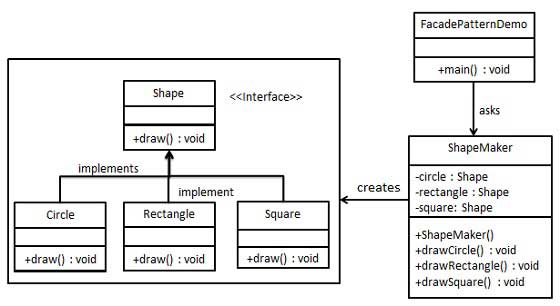设计模式:外观模式
外观模式
概念
外观模式(Facade Pattern)隐藏系统的复杂性,并向客户端提供了一个客户端可以访问系统的接口。这种类型的设计模式属于结构型模式,它向现有的系统添加一个接口,来隐藏系统的复杂性。
这种模式涉及到一个单一的类,该类提供了客户端请求的简化方法和对现有系统类方法的委托调用。
实现
我们将创建一个 Shape 接口和实现了 Shape 接口的实体类。下一步是定义一个外观类 ShapeMaker。
ShapeMaker 类使用实体类来代表用户对这些类的调用。FacadePatternDemo,我们的演示类使用 ShapeMaker 类来显示结果。
步骤 1
创建一个接口。
Shape.java1
2
3public interface Shape {
void draw();
}
步骤 2
创建实现接口的实体类。
Rectangle.java1
2
3
4
5
6
7public class Rectangle implements Shape {
public void draw() {
System.out.println("Rectangle::draw()");
}
}
Square.java1
2
3
4
5
6
7public class Square implements Shape {
public void draw() {
System.out.println("Square::draw()");
}
}
Circle.java1
2
3
4
5
6
7public class Circle implements Shape {
public void draw() {
System.out.println("Circle::draw()");
}
}
步骤 3
创建一个外观类。
ShapeMaker.java1
2
3
4
5
6
7
8
9
10
11
12
13
14
15
16
17
18
19
20
21public class ShapeMaker {
private Shape circle;
private Shape rectangle;
private Shape square;
public ShapeMaker() {
circle = new Circle();
rectangle = new Rectangle();
square = new Square();
}
public void drawCircle(){
circle.draw();
}
public void drawRectangle(){
rectangle.draw();
}
public void drawSquare(){
square.draw();
}
}
步骤 4
使用该外观类画出各种类型的形状。
FacadePatternDemo.java1
2
3
4
5
6
7
8
9public class FacadePatternDemo {
public static void main(String[] args) {
ShapeMaker shapeMaker = new ShapeMaker();
shapeMaker.drawCircle();
shapeMaker.drawRectangle();
shapeMaker.drawSquare();
}
}
步骤 5
验证输出。1
2
3Circle::draw()
Rectangle::draw()
Square::draw()
使用场景
- 当要为一个复杂子系统提供一个简单接口时可以使用外观模式
- 客户程序与多个子系统之间存在很大的依赖性。引入外观类将子系统与客户以及其他子系统解耦,可以提高子系统的独立性和
可移植性
模式总结
- 外观模式的主要优点就在于减少了客户与子系统之间的关联对象,使用客户对子系统的使用变得简单了,也实现了客户与子
系统之间的松耦合关系。它的缺点就在于违背了“开闭原则” - 如果需要实现一个外观模式,需要将子系统组合进外观中,然后将工作委托给子系统执行
参考资料: